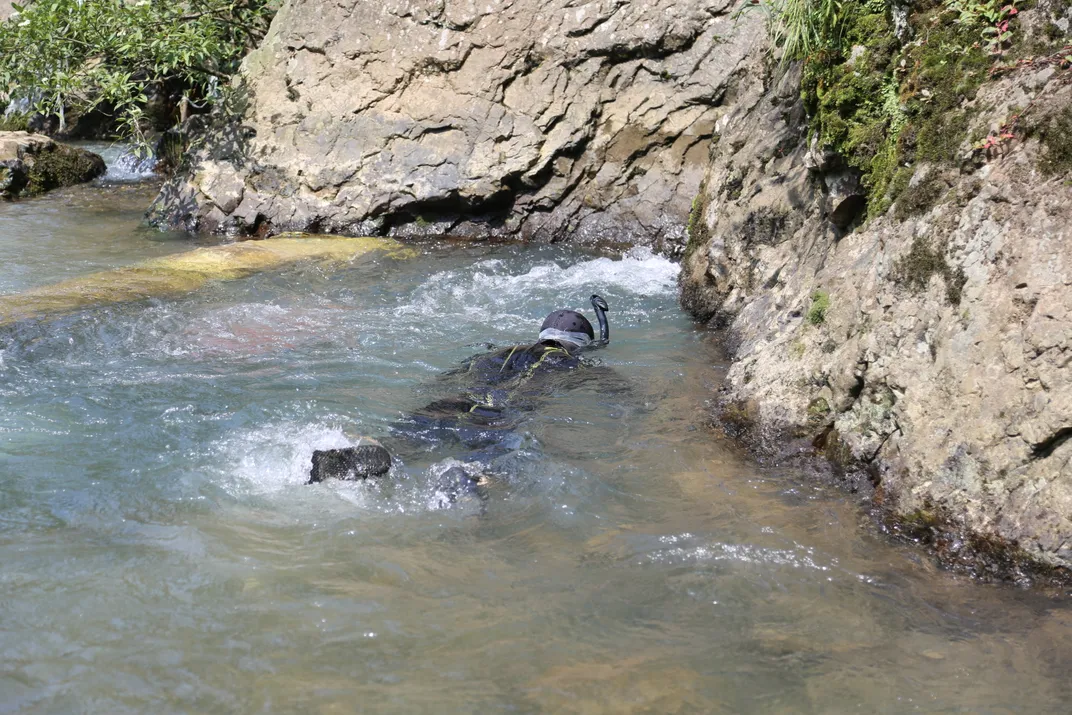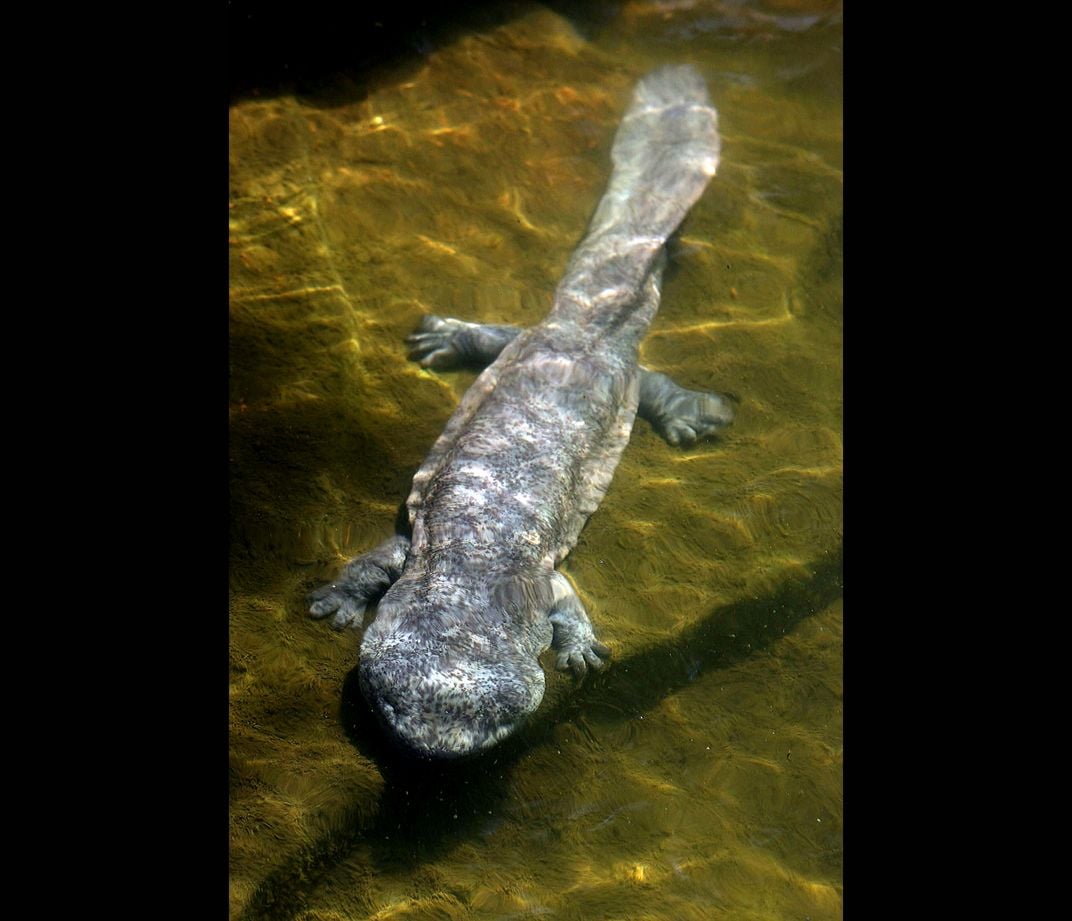The Adorable Chinese Giant Salamander Is Slithering Toward Extinction
The amphibians could actually be five separate species, some of which may already be extinct
/https://tf-cmsv2-smithsonianmag-media.s3.amazonaws.com/filer/12/22/122267d3-41e5-4b2b-a62b-fa431438d48d/this_photo_shows_jing_che_and_the_chinese_giant_salamander_photo_taken_by_robert_murphy.jpg)
There’s no other way to say it: the Chinese giant salamander is a cutie. Like the charismatic axolotl, this amphibian's limbs are adorably stubby for its size, and a smug smile constantly plays at the corners of its slimy black mouth. But unlike most salamanders, Chinese giants can grow to nearly six feet—yes, six feet—long.
Despite (or perhaps because of) their formidable size, the Chinese giant salamanders are in trouble. They're a prized food in their native country, with some creatures selling for more than $1,500 apiece. This human demand has devastated wild populations, leaving them critically endangered. To assess the state of these wild populations, an international team of researchers recently conducted the most exhaustive survey of wild populations to date. In a related study, researchers teased out the genetics of a large sample of the salamanders.
The results reveal some surprises. For one thing, genetics suggest that what was once thought to be one species may actually be five species. But no matter how you count them, one thing is clear: Chinese giant salamanders are heading for extinction.
The massive survey spanned four years and covered 97 sites across 16 Chinese provinces of amphibian habitat in China. The effort stems from the Zoological Society's EDGE of existence program, which strives to identify creatures that are not only critically threatened but evolutionarily distinct. And by those criteria, the Chinese giant salamander is a model organism.
Chinese giants are one of three known modern species of giant salamander, all of which diverged from other amphibians roughly 170 million years ago (the other two species live in North America and Japan). Relics of a time before the dinosaurs, these aquatic giants hail from a period when amphibians dominated the landscape. And they've changed surprisingly little since.
"In a sense, [the giant salamander] is like the last vestige of this previous freshwater megafauna," says Samuel Turvey, a senior research fellow at the Zoological Society of London and an author on both new studies. "If you lose any of those species you're losing part of a very long branch of evolutionary history, rather than just a twig."
And based on the new research, it appears that at least one of those branches may soon be lost. "Long story short, we found almost no animals anywhere in the wild—and the animals that we found may have not been wild individuals," says Turvey.

Throughout the exhaustive search, the researchers only located 24 Chinese giant salamanders in the wild. But it gets worse: After analyzing their genetics, says Turvey, it appeared that these salamanders were escapees or releases from commercial salamander farms, where millions of the creatures are grown for food.
Though the wild-caught salamanders hailed from three different river drainage systems, the 12 tested all showed genetic ties to natives of the Yellow River, the site of the oldest and largest breeding center.
"That's not to say that there aren't any [wild animals]," says Andrew Cunningham, deputy director of science at the Zoological Society of London and an author of both papers—but the low numbers found certainly aren't a good sign. In order to collect a representative sample of the population, the researchers used a randomized selection of sample sites. As Cunningham notes, there could still be some isolated reserves of the animals. But whether those creatures are also escapees or releases from the farms remains unknown.
"This is really bad news, and really concerning," says Mizuki Takahashi, a herpetologist at Bucknell University who specializes in Japanese giant salamanders and was not involved in the latest studies. He calls the small number of creatures they found "shocking,” given the wide search area.
The state of salamander conservation became even more worrisome when researchers took a deep dive into the giants' genetics. As detailed in the second study, researchers traced the genetics of 70 previously wild-caught and 1,032 farm-bread Chinese giants to trace their historical populations, discovering they were much more evolutionarily distinct than previously thought.
The results suggest that the Chinese giant salamander, which was thought to be one species, may actually be comprised of at least five distinct lineages that developed independently in isolated locales over millions of years. As Takahashi notes, whether or not these lineages are true "species," depends on the chosen definition of a species. But regardless of terminology, the researchers found that the mixing of genetics both within farms and between farms and wild populations may have already driven some of these lineages to extinction.
Amy McMillan, professor of biology at SUNY Buffalo State College, likens the problem to farm-raised salmon and wild salmon on the North American coasts. "If you have a small population, and you throw in a hundred new individuals, you can genetically swamp out that adapted population in a very short period of time," she says.
And that could be a problem. Some of the lines can be traced back millions of years, and in all likelihood are highly adapted to their specific environments, explains McMillan, who wasn't involved in the study. Because of this, each genetic lineage may not be able to thrive in all freshwater streams in China.
Even more concerning is the possibility of losing all Chinese giant salamanders. The creatures are top predators, chowing down on worms, insects, crayfish and even smaller salamanders. A loss of animals at the top of the food chain could cascade through system, resulting in imbalances in the populations of different species. As Turvey says dryly: "It probably wouldn't be a good thing to lose a top predator."

As the researchers write in their paper, the problems with genetic mixing are further magnified by "well-intentioned, but misguided" conservation efforts by China's Ministry of Agriculture. The ministry supports the release of farmed salamanders—often fully hybridized in the breeding centers—back into the wild. Since 2008, at least 72,000 Chinese giant salamanders have been released.
The fate of these captive releases remain unknown. But, as Turvey points out, the results of this latest survey suggest most either die out or get poached to help stoke farmed populations, which struggle to breed captive born individuals. Though giant salamanders were scarce, the researchers did find widespread evidence of illegal poaching—including traps, hooks, and remnants suggesting collection using electrofishing and poison.
But not all hope is lost. Researchers say that the latest work could inform a new version of the Chinese captive release programs, focusing on maintaining genetic lineages. The massive numbers of giants in farms—many of which were likely recently taken from the wild—may still contain some of these original genetic lines, Turvey notes.
These creatures could form the basis for conservation breeding programs. But both Turvey and Cunningham emphasize the need to for genetic checks and disease screening for all released individuals. "I think there's tremendous potential in the Chinese governmental support for this process," says Turvey.
However, for successful conservation, poaching must also be stopped—a massive task that will require major government action, Cunningham adds. Punishments must be enforced and wild-caught critters appropriately returned to their environment. "There's literally no point in putting animals back if they're just going to get poached straight away," says Turvey.
/https://tf-cmsv2-smithsonianmag-media.s3.amazonaws.com/accounts/headshot/Wei-Haas_Maya_Headshot-v2.png)
/https://tf-cmsv2-smithsonianmag-media.s3.amazonaws.com/accounts/headshot/Wei-Haas_Maya_Headshot-v2.png)